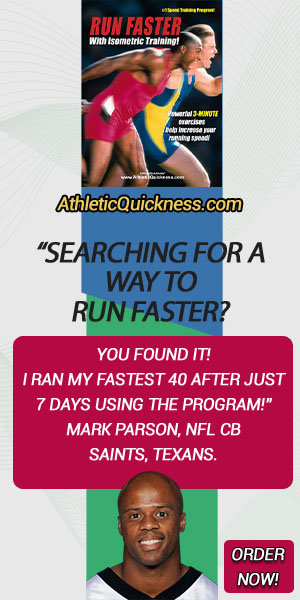“WOW! THAT GUY HAS A STRONG LEG!”
Why is the smallest guy on the team getting credit
for having the strongest leg on the team?
We’ve all seen and heard of it before. You are there watching a good football game, and a punter, backed-up into his own end zone, drills a 70 yarder dashing any hope of the opposing team working with a short field. Or, just before halftime or the end of a game, a place kicker nails a 55+ yarder.
And what is it that we hear from the announcers? “Wow, that guy has a strong leg!”
Standing 6’1″ and weighing 175 pounds soaking wet, I can tell you as a former kicker myself that I did not have the strongest leg on my team. In fact, I would be willing to bet that I had the weakest leg on my team with compared to the physical strength of others in the weight room.
Yet, everyone believed I had a strong leg. Early on in my career this was flattering to hear. But, behind the scenes, and especially in the weight room, everyone knows the offensive and defensive linemen are the real strong men — the ones with legendary feats of strength. But the funny thing is, you never hear anyone praising them for having a strong leg.
Why don’t those with the strongest leg muscles kick the ball farther?
So, two questions you have to ask are:
1) If linemen have the strongest legs on the team, why aren’t they doing the kicking?
2) Does the kicker really have a strong leg, or is it a more appropriate to ask if the kicker REALLY has a quick or fast leg?
These sounds like stupid questions, but when you consider that a typical college offensive lineman can squat upwards of 500 pounds and leg press upwards of 700 pounds, and the average kicker is lucky to do 300 and 500 respectively, it is something worth questioning.
So, with the obvious differences in strength between these two positions, where is this difference made up by the punters and kickers that enables them to firmly establish themselves on the team as having “the strongest leg?”
The answer is: Punters and kickers have quicker muscular contraction rates in the muscles responsible for performing a punt, kickoff or field goal than linemen trying to perform the same skill..
Or in other words: The leg muscles of kickers accelerate the speed of the leg much quicker. Therefore when the foot meets the ball, the leg of the kicker is moving much faster than the leg of a lineman.
This boils down to a simple physics equation. If you’re up to speed in this area, then you know that
F=MA or Force(F) = Mass(M) x Acceleration (A).
If we put aside that punting and kicking are specialized skills involving timing and ball placement on the kicker’s foot, the distance then that a ball will travel is directly related to the amount of mass (M) striking the ball times the amount of acceleration (A) or, speed.
Now I don’t think there is much argument in the fact that an offensive or defensive lineman’s leg and foot have more mass than the average kicker’s, so we will credit them for that. So, the difference in the amount of force (F) generated has to be in the amount of speed/acceleration (A) that a kicker’s leg and foot impacts into the ball.
And, I am willing to bet that the average kicker can swing his leg between 2-5 times faster than the average lineman, and this is more than enough of a difference to compensate for any difference of physical strength in the weight room, thus resulting in a greater ability to kick a ball.
[sc name=”2step-optin”]
So where does this speed come from?
First, consider the muscles involved in performing a punt or kick. The muscles involved in punting are the thigh/hip flexors and quadriceps:
Thigh/Hip Flexors
Psoas
Iliacus
Sartorius
Vastus Rectus
Pectineus
Adductor Magnus
Adductor Brevis
Quadriceps
Vastus Lateralis
Vastus Rectus
Vastus Medialis
Vastus Intermedius
And, for performing a soccer style field goal or kickoff, we have one additional muscle group, the Adductors:
Adductors
Adductor Magnus
Adductor Longus
Adductor Brevis
Gracilis
These are the muscles involved in performing punting and kicking skills.
The speed of these muscles does not come in the weight room. It never has and never will, and kicking a ball very far is proof of that.
The speed can only come by conditioning the fast twitch muscle fibers found within the muscles. These are the muscle fibers that cause the muscle to respond with explosive speed and quickness.
And the best way to train the fast twitch fibers is by using products that by their very nature transfer speed qualities back into the muscles that are opposing them.
Here at Athletic Quickness.com we have a saying that says
“Athletes become like that which they train.”
If you train with dynamic elastic resistance bands using an isometric training strategy the way we show you, then you will athletically become more dynamic, more responsive, and best of all, faster.
The KICK FARTHER and RUN FASTER with Isometric Training program will help you to accomplish at least two of your athletic goals:
1) Kick farther whether it be a punt, field goal (soccer style or straight on), kick off (soccer style or straight on) or kicking on the soccer field; and
2) Help you run faster than ever before because the KICK FARTHER and RUN FASTER with Isometric Training program contains all of the RUN FASTER with Isometric Training program exercises.
[sc name=”2-stepoptin-blue”]
[sc name=”soccer testimonial banner – green”]
[sc name=”Order Here Button-01″]
Always glad to help,
Dr. Larry Van Such






